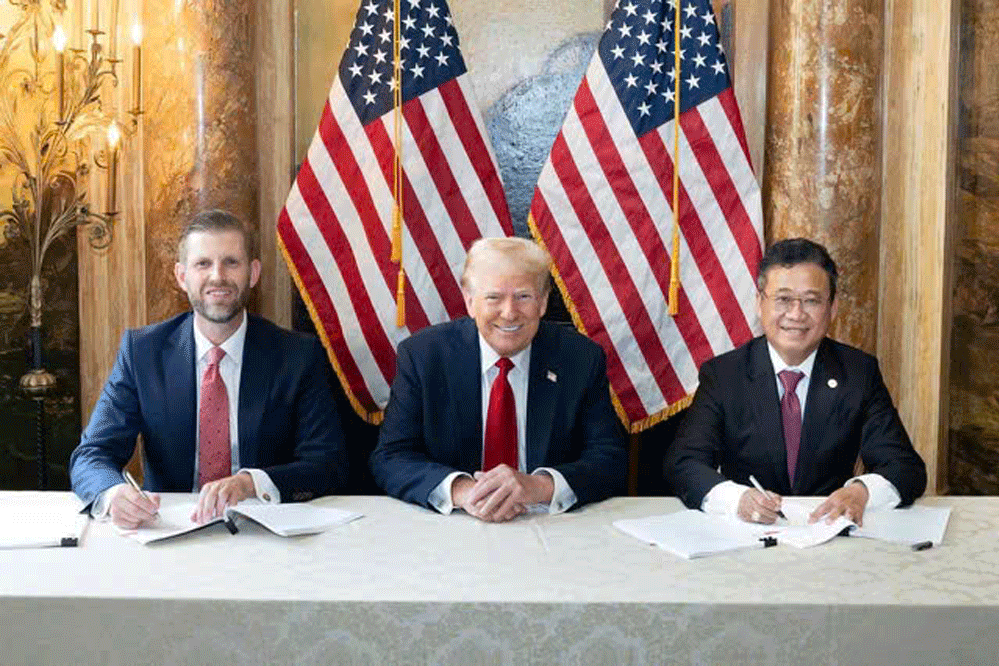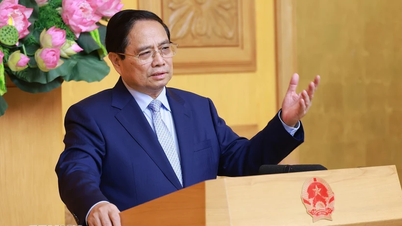USD plunges, gold price recovers weakly
The US dollar has just had a volatile week, with the Dollar Index (DXY) hitting its lowest level since February 2022, down to 97 points on June 26. The greenback has fallen for four consecutive days, the longest streak since March.
The decline reflected market concerns about the impact of President Donald Trump's tariff policies and uncertainty over the independence of the US Federal Reserve (Fed).
When Mr Trump began his second term in early 2025, the dollar surged for about two months, fueled by expectations of tax cuts and tariffs, with the DXY index reaching 110 in mid-January.
However, Trump’s unpredictable moves, including repeatedly announcing, postponing, or changing tariff plans, have created great uncertainty in financial markets. In particular, the 90-day reciprocal tariff suspension, scheduled to end on July 9, is raising concerns about an escalating trade war.
A June 25 report from JPMorgan Chase warned that these tariff policies could slow US economic growth and push up inflation, with the risk of a recession reaching 40%.
Uncertainty is further compounded by reports that Mr. Trump is considering nominating a new replacement for Fed Chairman Jerome Powell as early as September or October, much earlier than the end of Mr. Powell's term (May 2026).

The move is seen as an attempt to weaken the position of Mr. Powell, who has been repeatedly criticized by Mr. Trump for not lowering interest rates. During his Senate testimony, Mr. Powell emphasized the need for caution in monetary policy due to the risk of inflation from tariffs, disappointing markets with the lack of signs of easing.
As a result, the USD exchange rate against major currencies such as the euro, British pound, and Swiss franc all fell sharply. The euro/USD exchange rate reached 1.168, the highest since October 2021, while the USD/franc hit its lowest level since 2011.
In the context of a weak USD, gold prices usually increase sharply. However, gold only recovered weakly after the previous decline, fluctuating around 3,320 USD/ounce on the morning of June 27 (Vietnam time).
This is because the return of stability in the Middle East due to the ceasefire between Israel and Iran, promoted by Mr. Trump, has reduced the demand for gold as a safe-haven asset. Mr. Trump’s policies to turn the Middle East into a stable and developed region, along with pressure on NATO to increase defense spending, have reduced the appeal of gold in the short term.
USD, gold prices only weaken in the short term
Although the US dollar is facing many challenges, experts say the currency's dominance is unlikely to be affected in the short term.
According to Angela Mae's article on GoBankingRates on June 22, the USD will remain the world's largest reserve currency, accounting for nearly 48% of global transactions via the SWIFT system in 2024, compared to 45% 10 years ago. The USD is superior in terms of reliability, liquidity, and market depth compared to other currencies.
Foreign capital flows into US Treasuries continue to support low interest rates and a growing bond market, cementing Wall Street's position as a global financial center.
However, Mr Trump’s policies are putting significant pressure on the USD. He has repeatedly pressured the Fed to lower interest rates, while threatening to impose high tariffs on BRICS countries if they move to replace the USD’s role in global trade. These moves, combined with uncertainty over trade negotiations with China and India, are increasing geopolitical and financial risks.
On June 25, in a surprise statement at the White House, Mr. Trump affirmed that Washington “signed a trade agreement with China.” But later, the White House corrected that the US and China had only reached a “framework agreement.” Negotiations with India have also encountered difficulties, and the US is likely to impose a 26% reciprocal tax if no consensus is reached before July 9, according to US media reports.
However, the US economy remains strong, supporting the USD. Foreign capital flows, the financial strength of Wall Street and the role of the USD in international payments are solid foundations.
However, countries such as China and India are pushing for local currency payments. The share of global US dollar reserves has fallen from 73% in 2001 to 58% in 2022, while the yuan is increasingly used in cross-border transactions.
However, no current currency, including the euro or the yuan, is capable of replacing the USD in terms of stability and global acceptance in the short term.
In terms of gold prices, the short-term trend continues to be bearish due to stability in the Middle East and expectations of diplomatic solutions from Mr. Trump, such as the possibility of resolving the conflict in Ukraine. However, in the long term, gold remains an attractive asset if geopolitical and trade tensions escalate or the USD continues to weaken. At that time, investors will return to gold.
Gold prices are forecast to fluctuate around $3,200-3,400/ounce in the second half of the year.


Source: https://vietnamnet.vn/ong-trump-lam-dieu-bat-ngo-gia-vang-dien-bien-la-dong-usd-lung-lay-vi-the-2415640.html












































































































Comment (0)